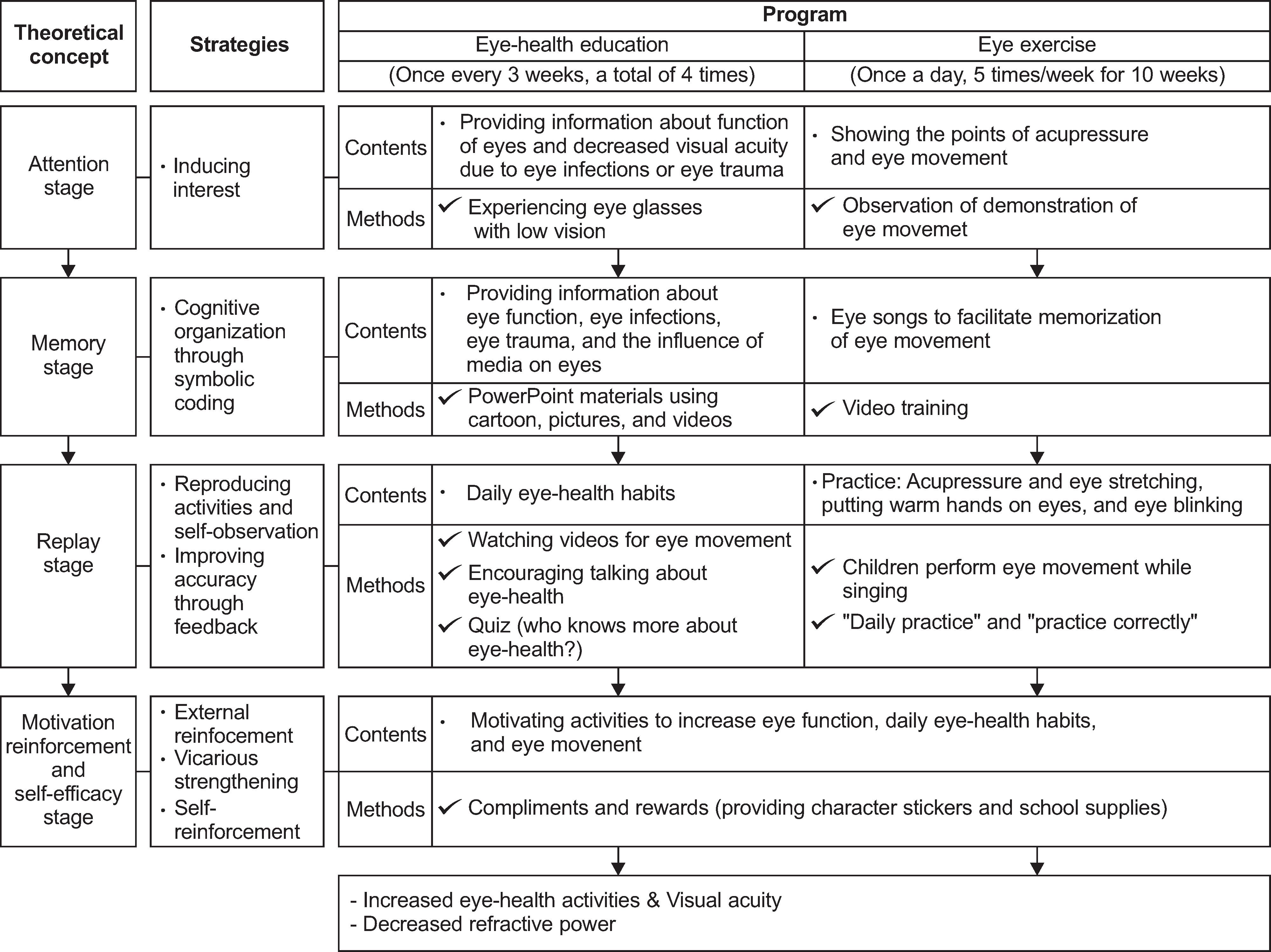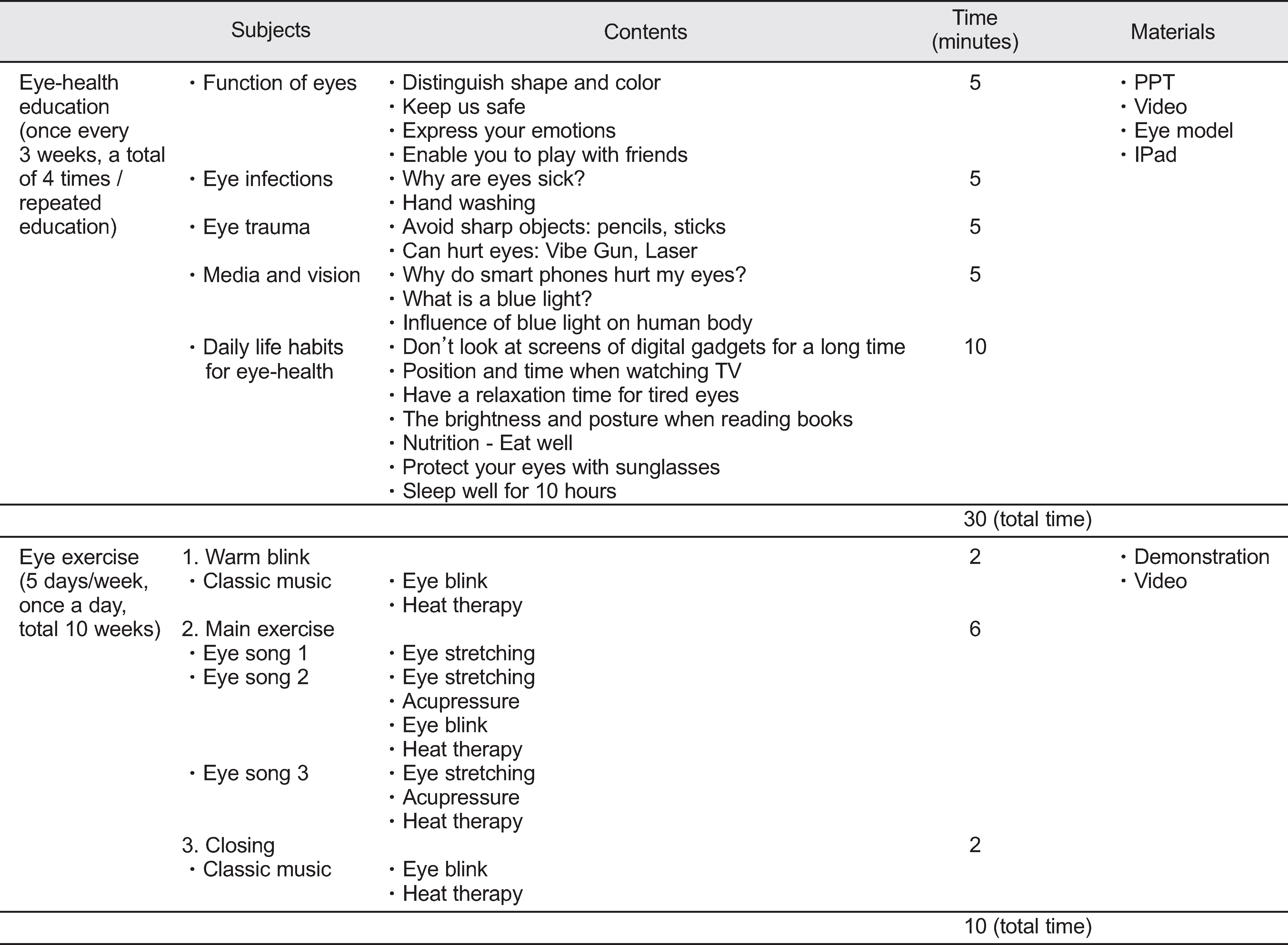J Korean Acad Nurs.
2018 Aug;48(4):407-418. 10.4040/jkan.2018.48.4.407.
Development and Effects of Social Learning Theory Based Eye-Health Program for Preschoolers
- Affiliations
-
- 1Department of Nursing, Gimhae College, Gimhae, Korea.
- 2College of Nursing, Pusan National University, Yangsan, Korea. haejung@pusan.ac.kr
- 3Ophthalmology, Otolaryngology and Dermatology of Korean Medicine, Pusan National University Korean Medicine Hospital, Yangsan, Korea.
- 4Ophthalmology of Pusan National University Hospital, Yangsan, Korea.
- KMID: 2424527
- DOI: http://doi.org/10.4040/jkan.2018.48.4.407
Abstract
- PURPOSE
The purpose of this study was to develop an eye-health program based on social learning theory (EPST) of preschoolers and evaluate its effectiveness.
METHODS
A nonequivalent control group pre-post test design was utilized and 141 six-year-old preschoolers and their parents participated (experimental group=69, control group=72) in the study. The EPST in this study included eye-health education and eye exercises. Attention, memory, replay, motivation, reinforcement, and self-efficacy were used as interventional strategies. To examine the effectiveness of EPST, proficiency in eye-health activities, refractive power, and visual acuity were measured before and after the intervention. Data were analyzed with SPSS WIN 21.0 using the Shapiro-Wilk test, χ2-test, Mann-Whitney U test and Wilcoxon signed rank test.
RESULTS
Following the intervention, eye-health activities, refractive power, and visual acuity significantly improved in the experimental group compared to the control group.
CONCLUSION
The results of this study suggest that EPST is effective in improving eye-health activities, refractive power, and visual acuity in preschoolers, and its wider implementation in educational institutions will promise improved eye-health among preschoolers.
Keyword
MeSH Terms
Figure
Reference
-
References
1. World Health Organization (WHO). Blindness and visual impairment. [Internet]. Geneva: WHO Media Centre;c2017. [cited 2017 Oct 11]. Available from:. http://www.who.int/mediacentre/factsheets/fs282/en/.2. Choi KW, Koo BS, Lee HY. Preschool vision screening in Korea: Results in2003. Journal of the Korean Ophthalmological Society. 2006; 47(1):112–120.3. Ministry of Health and Welfare. Amblyopia, It is difficult to return to normal vision if left untreated. [Internet]. Sejong: Division of Healthcare Policy, Ministry of Health and Welfare;c2015. [cited 2015 Mar 9]. Available from:. http://www.mohw.go.kr/react/al/sal0301vw.jsp?PAR_MENU_ID=04&MENU_ID=0403&CONT_SEQ=317564&page=1.4. Harper AR, Summers JA. The dynamic sclera: Extracellular matrix remodeling in normal ocular growth and myopia development. Experimental Eye Research. 2015; 133:100–111. https://doi.org/10.1016/j.exer.2014.07.015.
Article5. Ip JM, Huynh SC, Robaei D, Rose KA, Morgan IG, Smith W, et al. Ethnic differences in the impact of parental myopia: Findings from a population-based study of 12-year-old Australian children. Clinical and Epidemiologic Research. 2007; 48(6):2520–2528. https://doi.org/10.1167/iovs.06-0716.
Article6. Lee WS, Ye KH, Shin BJ. A study on the progression and prevalence of myopia according to age for the last five years: From 2008 to2012. Journal of Korean Ophthalmic Optics Society. 2014; 19(1):121–133. https://doi.org/10.14479/jkoos.2014.19.1.121.7. Ghaderi S, Hashemi H, Jafarzadehpur E, Yekta A, Ostadi-moghaddam H, Mirzajani A, et al. The prevalence and causes of visual impairment in seven-year-old children. Clinical and Experimental Optometry. 2018; 101(3):380–385. https://doi.org/10.1111/cxo.12646.
Article8. Fan DS, Lam DS, Lam RF, Lau JT, Chong KS, Cheung EY, et al. Prevalence, incidence, and progression of myopia of school children in Hong Kong. Investigative Ophthalmology & Visual Science. 2004; 45(4):1071–1075. https://doi.org/10.1167/iovs.03-1151.
Article9. Harley RD. Disorders of the lids. Pediatric Clinics of North America. 1983; 30(6):1145–1158. https://doi.org/10.1016/S0031-3955(16)34507-2.
Article10. Shin HS, Park SC, Park CM. Relationship between accommodative and vergence dysfunctions and academic achievement for primary school children. Ophthalmic and Physiological Optics. 2009; 29(6):615–624. https://doi.org/10.1111/j.1475-1313.2009.00684.x.
Article11. Rim TH, Park HJ, Woo YJ, Kim SS. Factors associated with vision screening in children: The Korea National Health and Nutrition Examination Survey. Journal of the Korean Ophthalmological Society. 2015; 56(6):944–949. https://doi.org/10.3341/jkos.2015.56.6.944.
Article12. Ye KH, Lee WS. A study on the actual condition of uncorrected refractive error of preschool children and adolescents. The Korean Journal of Vision Science. 2015; 17(1):21–30.
Article13. Mun KA, Lee MS, Na BJ, Lee JY, Hong JY, Bae SH, et al. Related factors with decreased visual acuity of elementary school students. The Korea Academia-Industrial Cooperation Society. Proceedings of the Fall Conference of Korea Academia-Industrial Cooperation Society; 2010 Nov 12-13. Jeju: The Korea Academia-Industrial Cooperation Society;2010. p. 677–680.14. Cho MJ, Song HR. An analysis on the factors and realities with low visual acuity by leisune activity of growth period in elementary school children. Journal of Sport and Leisure Studies. 2001; 16:1295–1315.15. Park GH, Kim YJ, Cho HM, Shin SC, Hwang SG. A study on the change of visual activity and refractive angle through eye exercise. Korean Journal of Physical Education. 1991; 30(1):1117–1121.16. Joo DH. Change of eyesight and refraction through eye exercise for elementary school children [master’s thesis]. Incheon (Korea): Incheon National University Graduate School of Education, Incheon;2002. p. 1–47.17. Yeh ML, Chen HH, Chung YC. One year study on the integrative intervention of acupressure and interactive multimedia for visual health in school children. Complementary Therapies in Medicine. 2012; 20(6):385–392. https://doi.org/10.1016/j.ctim.2012.09.001.
Article18. Lin Z, Vasudevan B, Fang SJ, Jhanji V, Mao GY, Han W, et al. Eye exercises of acupoints: Their impact on myopia and visual symptoms in Chinese rural children. BMC Complementary and Alternative Medicine. 2016; 16:349. https://doi.org/10.1186/s12906-016-1289-4.
Article19. Son WI. Effects of an ocular movements program of personal scope-EX on visual acuity of elementary school students. Journal of Korean Society for the Study of Physical Education. 2012; 17(1):97–109.20. Oh JJ, Shin HS. The effect of visual health promotion program in elementary school-Age children. Journal of Korean Academy of Community Health Nursing. 2001; 12(2):397–405.21. Hockenberry MJ, Wilson D. Wong’s nursing care of infants and children. 9th ed. St. Louis (MO): Elsevier Mosby;2011. p. 585–606.22. Bandura A. Social learning theory. Englewood Cliffs (NJ): Prentice-Hall Inc.;1977. p. 2–55.23. Yoon YM. The effects of visual health promotion program for preschool children. The Journal of Korean Academic Society of Nursing Education. 2006; 12(2):257–264.24. Waltz CF, Bausell RB. Nursing research: Design, statistics, and computer analysis. Philadelphia: F.A. Davis Co.;1981. p. 71.25. Everitt BS. Multivariate analysis: The need for data, and other problems. British Journal of Psychiatry. 1975; 126(3):237–240. https://doi.org/10.1192/bjp.126.3.237.
Article26. Arana Mendez M, Arguello L, Martinez J, Salas Vargas M, Alvarado Rodriguez AM, Papa CE, et al. Evaluation of the spot vision screener in young children in Costa Rica. Journal of American Association for Pediatric Ophthalmology and Strabismus. 2015; 19(5):441–444. https://doi.org/10.1016/j.jaapos.2015.08.002.
Article27. Koo ST, Kim YS, Yim YK, Choi SM, Kang SK. Understanding of the WHO standard acupuncture point locations in the western pacific region: General guidelines. Korean Journal of Acupuncture. 2010; 27(2):1–11.28. Li SM, Kang MT, Peng XX, Li SY, Wang Y, Li L, et al. Efficacy of Chinese eye exercises on reducing accommodative lag in school-aged children: A randomized controlled trial. Public Library of Science One. 2015; 10(3):e0117552. https://doi.org/10.1371/journal.pone.0117552.
Article29. Lee JY. Bandura’s social learning theory applying to furniture design education: Focused on specialized high school [master’s thesis]. Seoul: Kookmin University, Seoul;2016. p. 1–126.
- Full Text Links
- Actions
-
Cited
- CITED
-
- Close
- Share
- Similar articles
-
- A Program to Build Preschooler's Eating Habit Based on Social Cognitive Theory
- Behavior Therapeutic Approach with Social Learning Theory: Based on Social Learning Theory of Bandura
- Social Cognitive Theory and Medical Education: How Social Interactions Can Inform Learning
- Social Cognitive Theory and Medical Education: How Social Interactions Give Rise to Learning
- Effects of a Physical Activity Program based on Social Cognitive Theory for Old-Old Women with Knee Osteoarthritis



